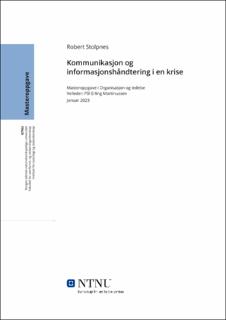| dc.contributor.advisor | Pål Erling Martinussen | |
| dc.contributor.author | Robert Stolpnes | |
| dc.date.accessioned | 2023-05-04T17:19:16Z | |
| dc.date.available | 2023-05-04T17:19:16Z | |
| dc.date.issued | 2023 | |
| dc.identifier | no.ntnu:inspera:134654674:52732228 | |
| dc.identifier.uri | https://hdl.handle.net/11250/3066296 | |
| dc.description.abstract | Sammendrag
Koronapandemien ble håndtert svært ulikt da den rammet i 2020. Fagmiljøer og myndigheter i ulike land oppfattet trusselen forskjellig, og det var utfordrende å danne en felles og korrekt situasjonsforståelse. Det var viktig å gi hyppig og god informasjon om endringer, tiltak og smittesituasjonen i takt med informasjonsgrunnlaget man hadde. God kommunikasjon var viktig og avgjørende for valg av strategi, og det handlet om å være åpen om usikkerheten, gi tidlig informasjon og kommunisere råd og tiltak enkelt og tydelig.
Tema for denne studien er kommunikasjon og informasjonshåndtering i en krise. Min problemstilling er formulert slik: Hvordan kommuniserte enhetslederne i hjemmetjenesten med sine ansatte under covid-19 pandemien? Studien retter seg mot å finne svar på hvordan enhetslederne i Trondheim kommune sikret god informasjonsflyt til de ansatte og om det var noen suksessfaktorer i deres kommunikasjon.
Det empiriske bidraget i denne studien er basert på en kvalitativ forskningsmetode, med til sammen fire intervjuer av enhetsledere for hjemmetjenesten i Trondheim kommune. Det er gjort to fysiske og to digitale intervju med lydopptak som er transkribert før informasjonen ble analysert og drøftet.
Enhetslederne ledet hjemmetjenesten forskjellig under nedstengingen sammenlignet med en normalsituasjon. Det fremtredende i denne studien var at lederne måtte endre sin lederstil og ha en situasjonsbestemt tilnærming, i tillegg til å være mer autoritær i sin måte å kommunisere på. Fysisk tilstedeværelse for å skape trygghet og tillit blant sine ansatte var en vesentlig suksessfaktor. Da informasjonsgrunnlaget stadig endret seg, har de tilstrebet å gi oppdatert informasjon for å skape en felles situasjonsforståelse. For å få til dette var det nødvendig å gjenta, sammenfatte og konkretisere, da mengden informasjon var enorm.
Nøkkelord: Ledelse, lederstil, kommunikasjon, informasjonshåndtering, krise. | |
| dc.description.abstract | Summary
The coronavirus pandemic was handled very differently when it hit in 2020. Professional communities and authorities in different countries perceived the threat differently, and it was challenging to establish a common and correct understanding of the situation. It was important to provide frequent and good information about changes, measures, and the infection situation in line with the information available at the time. Effective communication was crucial in determining course of action for organizations, and it involved being transparent about uncertainties, providing timely information, and clearly communicating guidelines and measures.
The theme of this study is communication and information management in a crisis. My research question is formulated as follows: How did the home care unit managers communicate with their employees during the pandemic? The study aims to find answers to how the unit managers in the Trondheim municipality ensured good information flow to the employees, and to highlight any obvious success factors in terms of how they communicated.
The empirical contribution in this study is based on a qualitative research method, with a total of four interviews with home care unit managers in the Trondheim municipality. Two physical and two digital interviews were conducted with audio recordings that were transcribed before the information was analyzed and discussed.
The unit managers led the home care service differently during the lockdown compared to a normal situation. The key finding in this study was that the leaders had to change their leadership style and adopt a more situation-specific approach, in addition to being more authoritarian in their communication methods in general. Having a physical presence in order to maintain a feeling of security and trust among employees, was a success factor. Given that the information base was constantly changing, the managers sought to quickly forward information to establish a common understanding of the situation. To achieve this, it was necessary to repeat, summarize and concretize information, as the amount of information was vast.
Keywords: Leadership, leadership style, communication, information management, crisis. | |
| dc.language | nob | |
| dc.publisher | NTNU | |
| dc.title | Kommunikasjon og informasjonshåndtering i en krise | |
| dc.type | Master thesis | |
